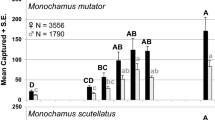Abstract
A sticky trap with 3 m2 surface area was modified by changes in attractant release rate, vertical dispersion of the attractant, and addition of a tree trunk silhouette to the trap axis. As attractant release rate increased, the number ofDendroctonus brevicomis caught at the source of attractant and at 1.5 and 5.2 m above ground on two vertical silhouettes 4.5 m away increased. In one experiment, more beetles were caught at a dispersed source of attractant than at a point source. Fewer beetles were caught at the lower traps on the two outlying silhouettes when a silhouette was at the source, than when no silhouette was at the source. As attractant release rate increased, the catch of a predator,Temnochila chlorodia, increased at the source.
Similar content being viewed by others
References
Bedard, W.D., andBrowne, L.E. 1969. A delivery-trapping system for evaluating insect chemical attractants in nature.J. Econ. Entomol. 62:1202–1203.
Bedard, W.D.,andWood, D.L. 1974. Programs utilizing pheromones in survey and control: Bark beetles—the western pine beetle, pp. 441–449,in M.C. Birch (ed.). Pheromones. North-Holland, Amsterdam.
Bedard, W.D., Tilden, P.E., Wood, D.L., Silverstein, R.M., Brownlee, R.G., andRodin, J.O. 1969. Western pine beetle: Field response to its sex pheromone and a synergistic host terpene, myrcene.Science 164:1284–1285.
Bedard, W.D., Wood, D.L., Tilden, P.E., Lindahl, K.Q., Jr., Silverstein, R.M.,andRodin, J.O. 1980. Field responses of the western pine beetle and one of its predators to host- and beetle-produced compunds.J. Chem. Ecol. 6:625–641.
Browne, L.E., 1978. A trapping system for the western pine beetle using attractive pheromones.J. Chem. Ecol. 4:261–275.
Coster, J.E., andGara, R.I. 1968. Studies on the attack behavior of the southern pine beetle. II. Response to attractive host material.Contrib. Boyce Thompson Inst. 24:69–76.
Cuthbert, R.A., andPeacock, J.W. 1978. Response of the elm bark beetle,Scolytus multistriatus (Coleoptera: Scolytidae), to component mixtures and doses of the pheromone, multilure.J. Chem. Ecol. 4:363–373.
Gara, R.I., Vité, J.P., andCramer, H.H. 1965. Manipulation ofDendroctonus frontalis by use of a population aggregating pheromone.Contrib. Boyce Thompson Inst. 23:55–66.
Johnson, P.C. andCoster, J.E. 1978. Probability of attack by southern pine beetle in relation to distance from an attractive host tree.For. Sci. 24:574–580.
Kinzer, G.W., Fentiman, A.F., Jr., Page, T.F., Jr., Foltz, R.L., Vité, J.P., andPitman, G.B. 1969. Bark beetle attractants: Identification, synthesis, and field bioassy of a new compound isolated fromDendroctonus.Nature 221:477–478.
Knopf, J.A.E., andPitman, G.B. 1972. Aggregation pheromone for manipulation of the Douglas-fir beetle.J. Econ. Entomol. 65:723–726.
McCambridge, W.F. 1967. Nature of induced attacks by the Black Hills beetle,Dendroctonus ponderosae (Coleoptera: Scolytidae).Ann. Entomol. Soc. Am. 60:920–928.
Payne, T.L., Coster, J.E., Richerson, J.V., Hart, E.R., Hedden, R.L., andEdson, L.J. 1978. Reducing variation in field tests of behavioral chemicals for the southern pine beetle.J. Georgia Entomol. Soc. 13:85–90.
Rasmussen, L.A. 1972. Attraction of mountain pine beetles to small-diameter lodgepole pines baited withtrans-verbenol and alpha-pinene.J. Econ. Entomol. 65:1396–1399.
Scheffé, H. 1959. The Analysis of Variance. John Wiley & Sons, New York, 477 pp.
Silverstein, R.M., 1970. Methodology for isolation and identification of insect pheromones—examples from Coleoptera, pp. 285–299,in D.L. Wood, R.M. Silverstein, and M. Nakajima (eds.). Control of Insect Behavior by Natural Products. Academic Press, New York.
Silverstein, R.M., Beownlee, R.G., Bellas, T.E., Wood, D.L., andBrowne, L.E. 1968. Brevicomin: Principal sex attractant in the frass of the female western pine beetle.Science 159:889–891.
Tilden, P.E., Bedard, W.D., Wood, D.L., Lindahl, K.Q., andRauch, P.A. 1979. Trapping the western pine beetle at and near a source of synthetic attractive pheromone: Effects of trap size and position.J. Chem. Ecol. 5:519–531.
Vité, J.P., andPitman, G.B. 1969. Insect and host odors in the aggregation of the western pine beetle.Can. Entomol. 101:113–117.
Vité, J.P., andPitman, G.B. 1970. Management of western pine beetle populations: Use of chemical messengers.J. Econ. Entomol. 63:1132–1135.
Vité, J.P., andWilliamson, D.L. 1970.Thanasimus dubius: Prey perception.J. Insect Physiol. 16:233–239.
Wood, D.L., Browne, L.E. Ewing, B., Lindahl, K., Bedard, W.D., Tilden, P.E., Mori, K., Pitman, G.B., andHughes, P.R. 1976. Western pine beetle: Specificity among enantiomers of male and female components of an attractant pheromone.Science 192:896–898.
Author information
Authors and Affiliations
Additional information
Coleoptera: Scolytidae.
Based in part on a thesis submitted by Paul E. Tilden to the University of California, Berkeley, in partial fulfillment of the requirements for the Master of Science degree in entomology, December 1976. These studies were supported by the Forest Service, U.S. Department of Agriculture, and in part by the Rockefeller Foundation and a joint grant (NSF GB-34718/BMS 75-04223) from the U.S. National Science Foundation and the U.S. Environmental Protection Agency to the University of California. The findings, opinions, and recommendations are not necessarily those of the funding agencies or the University of California.
Mention of trade names is for information only and is not an endorsement by the funding or sponsoring agencies.
Rights and permissions
About this article
Cite this article
Tilden, P.E., Bedard, W.D., Lindahl, K.Q. et al. TrappingDendroctonus brevicomis Changes in attractant release rate, dispersion of attractant, and silhouette. J Chem Ecol 9, 311–321 (1983). https://doi.org/10.1007/BF00988451
Received:
Revised:
Issue Date:
DOI: https://doi.org/10.1007/BF00988451




